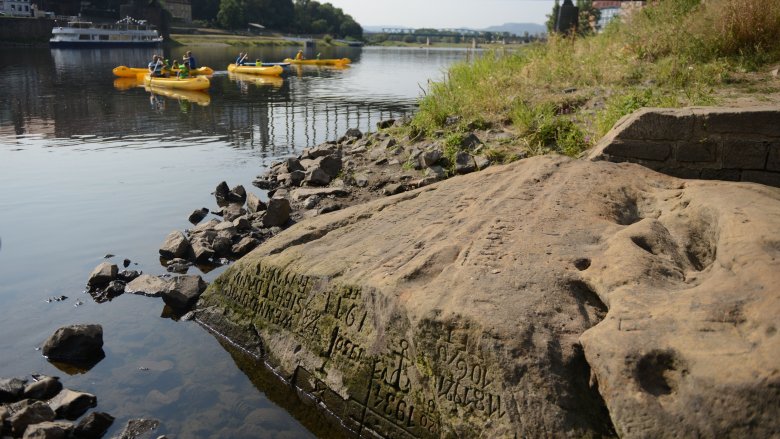The Drought That Revealed A Dark Medieval Message
A yearslong drought can devastate communities and ecosystems, and it can also reveal long-forgotten secrets. In 2014, for example, California's extended drought had claimed so much of the water in the state's reservoirs that visitors could walk through the remains of an old mining town that once sat near the bottom of Folsom Lake. In July 2018 a pair of hobbyists flying drones in Ireland found evidence of a late Neolithic monument, which was only visible because a prolonged drought caused changes in soil moisture that made it possible to see its ghostly imprint from the air. And by August 2018, the Elbe River in the Czech Republic had lost so much water that it had revealed "hunger stones," monuments to history's most devastating droughts that once lay hidden beneath the water line.
According to NPR, the hunger stones were placed on the banks of the river in antiquity to record low water levels. They were deliberately placed at the lowest water levels so they would remain hidden beneath the surface during times of normal rainfall and then would emerge during times of drought to serve as a warning to the people. They existed to tell the townsfolk that they were doomed, which frankly the townsfolk had probably already figured out by that point. In practice they were kind of like a very serious nose thumb from the past.
The authors of a 2013 paper on the subject wrote that one stone in particular — simply called "Hunger Rock," was "chiseled with the years of hardship and the initials of authors lost to history." The stone noted the years of especially bad drought, beginning with 1417, then 1616, 1707, 1746, and 1790. In the 1800s, the stone made note of seven different drought events. But the stone's authors weren't just satisfied with marking the date, they also left messages for future generations. Besides the list of years, the stone has an engraving that reads, "Wenn du mich siehst, dann weine," which means, "If you see me, weep."
There are more than a dozen hunger stones in and around the Czech town of Decin, which is close to the German border. They've become something of a tourist attraction, which probably is not what those suffering people from the past really had in mind ("If you see me, weep, but just watch where you let your kid step, please and thank you.") The stones were meant to convey a dire warning to those unlucky enough to witness the sorts of low water levels that once meant widespread suffering. In antiquity, drought not only threatened the harvest, it also made it difficult to travel on the river, which meant that the people living along the banks could no longer make ends meet. One stone in Germany reads, "If you will again see this stone, so you will weep, so shallow the water was in the year 1417." Another one reads, "We cried — We cry — And you will cry." Thanks for the pep talk, ancestors.
Not all the stones are doom and gloom, though. One stone in the Czech Republic reads, "Don't cry, girl, don't fret. When it's dry, just spray your field wet." Right, so just set your sprinklers to come on at 6 a.m. every other day and — oh, wait.
The reappearance of the hunger stones certainly sends a sinister message (except for the tourists, evidently), but there are other more ominous things that the receding water is revealing in the Elbe, which is at its lowest level in more than 50 years. Where the Elbe flows through the German states of Saxony-Anhalt and Saxony, people have uncovered unexploded World War II munitions, including grenades, landmines, and other explosives, which have been corroding happily beneath the surface for several decades now.
Today, drought in Western nations is still awful but not quite on the same scale it once was. Money and technology can offset much of the impact and can mostly prevent the sort of death and despair that was once the inevitable result of a prolonged drought. But the stones are still a reminder of how devastating drought can be in countries that don't have access to technology and/or the resources to just ride it out with patience and water rationing. And the warming climate means that drought is just going to become more and more commonplace — which ultimately may mean that the sinister warnings of the hunger stones will apply to Western nations, too. So pay attention, take short showers, landscape your yard with drought-resistant plants, and maybe stop letting your kids climb all over the danged hunger stones.
